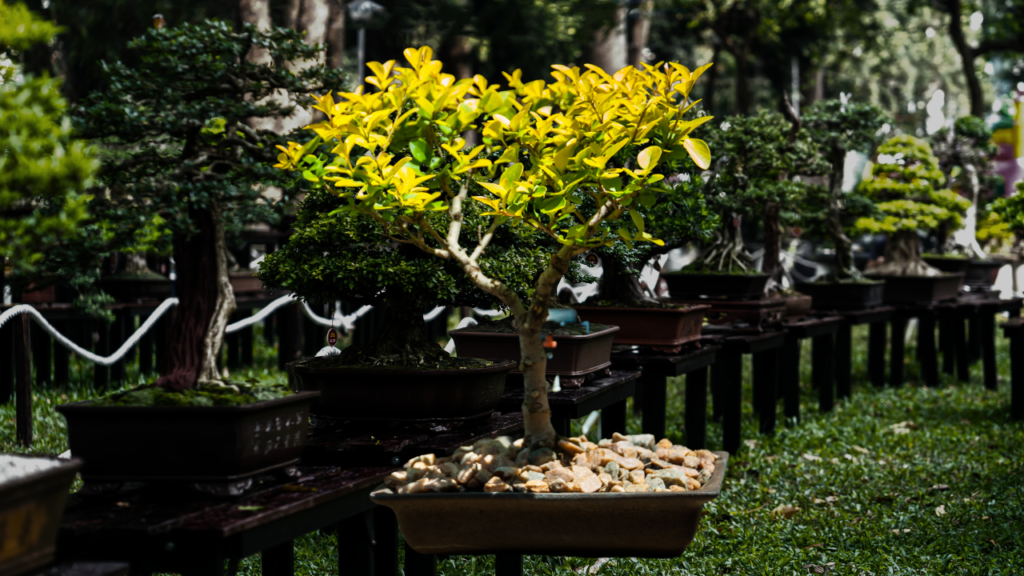Privets (Ligustrum species) are versatile and hardy trees, making them an excellent choice for bonsai cultivation. Their dense foliage, ability to withstand aggressive pruning, and adaptability to various bonsai styles have earned them a favored spot among bonsai enthusiasts. Here’s a comprehensive care guide tailored for Privet bonsai:
| Privet Bonsai Quick Reference | |
|---|---|
| Attribute | Information |
| 🌾Plant Type | Evergreen and deciduous shrub |
| ☀️Sun Exposure | Bright position with direct sunlight at least part of the day. Some species require indoor placement during winter. |
| ✂️Pruning | Timed well to ensure abundant flowering |
| 🌼Bloom Time | Summer (small white scented flowers) |
| 🍂Leaf Characteristics | Dark green leaves that vary in size and shape depending on the cultivar |
| 🌲Common Species Used | Chinese privet (Ligustrum sinensis), Japanese privet (Ligustrum japonicum), Oval leaved privet (Ligustrum ovalifolium), Shiny leaved privet (Ligustrum lucidum), Common privet (Ligustrum vulgare) |
| ❄️Hardiness | Protection required against hard frost for most species. Chinese privet should be placed indoors during winter. |
| 🌎Native Area | Varies by species |
1. Positioning and Light:
- Sunlight: Privets thrive in full sunlight but can also tolerate partial shade. Ensure they receive at least 4-6 hours of direct sunlight daily.
- Outdoor Living: Privets are best kept outdoors, benefiting from natural light and seasonal variations. However, they can be brought inside during extreme weather conditions.
2. Watering:
- Frequency: Water when the top layer of soil begins to dry out. Privets prefer consistent moisture but are also drought-tolerant once established.
- Method: Water thoroughly, ensuring the entire root ball is moistened, and allow excess water to drain from the pot.
3. Humidity:
- Privets aren’t particularly sensitive to humidity levels, but if you’re keeping them indoors or in a particularly dry climate, occasional misting can be beneficial.
4. Soil and Fertilizing:
- Soil: A well-draining soil mix is crucial. A blend of akadama, organic compost, and fine grit or pumice is recommended.
- Fertilizing: Feed every two weeks during the growing season (spring to early autumn) with a balanced liquid bonsai fertilizer. In winter, reduce feeding to once a month.
5. Pruning and Shaping:
- Pruning: One of the advantages of Privets is their tolerance to heavy pruning. Regularly trim to maintain the desired shape and promote dense foliage. Late winter or early spring, before new growth starts, is ideal for major pruning.
- Wiring: Privets are flexible and respond well to wiring. However, their rapid growth means you should monitor the wire to ensure it doesn’t cut into the bark.
6. Repotting:
- Young Privet bonsai benefit from repotting every 2 years, while mature trees can be repotted every 3-4 years. Spring is the optimal time for repotting.
- Trim up to a third of the root mass during repotting to encourage a robust root system.
7. Pests and Diseases:
- Privets can be susceptible to aphids, scale insects, and spider mites. Regularly inspect your tree and address any issues promptly using insecticidal soap or neem oil.
- Fungal diseases can also affect Privets, especially in wet conditions. Ensure good airflow around the tree and consider using a fungicide if issues arise.
8. Winter Care:
- While Privets are relatively cold-hardy, it’s a good practice to protect them from extreme cold and frost. A cold frame or mulching around the base can provide added protection.
9. Recognizing Privet Bonsai Features:
- Privets are recognized by their dense, dark green leaves, which can be semi-evergreen in milder climates. They also produce clusters of white flowers in summer, followed by black berries.
Bonsai Care Essentials
Conclusion:
Privet bonsai trees are a testament to adaptability and resilience. Their rapid growth and tolerance to various conditions make them an excellent choice for both beginners and seasoned bonsai practitioners. With attentive care and a passion for the craft, your Privet bonsai will stand as a lush, living sculpture, reflecting the beauty of nature in miniature.
